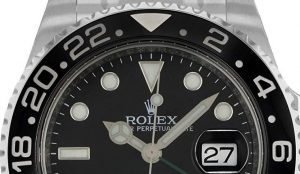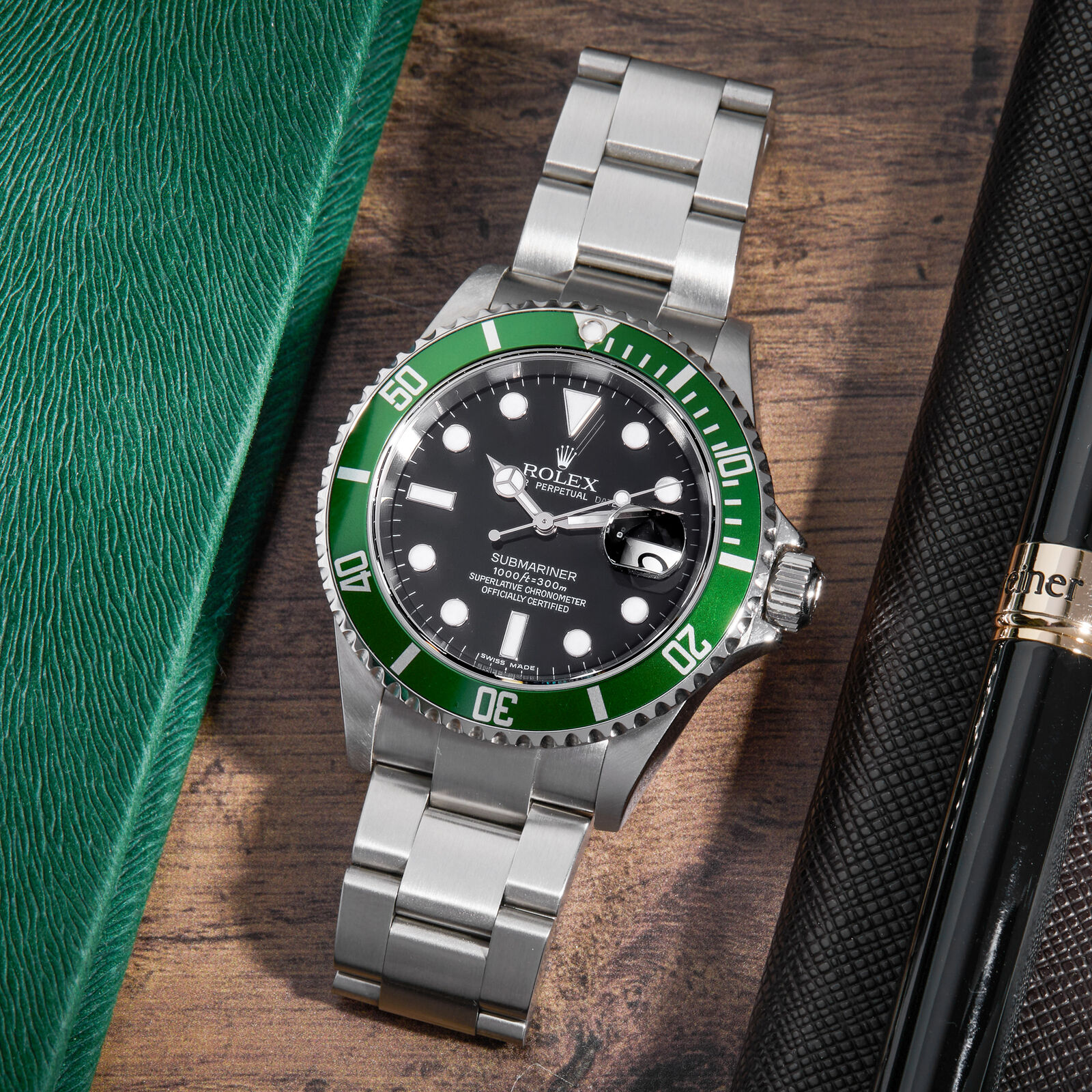Rolex Submariner vs GMT Master II
Close Siblings Since The 1950s
Rolex has been producing the Submariner since 1953, when it first display the watch to the public at the Basel World exhibition.
Similarly, it’s closest brother, the GMT was released at the end of the decade in 1959. This model was then given quite an update in the late 80s to give us what is now known as the GMT Master II, which features the “Fat Lady” style case and bezel, which the Submariner later came to adopt.
This means that both of these watches, especially when comparing the date version of the Submariner, are almost identical to the untrained eye. Almost.
But the devil as always in the detail, and in this post I am going to cover all the details, differences and similarities of these models.
I will mostly compare the GMT Master reference 116710 with the Submariner reference 114060, and 116610, because they are the most similar in terms of color.
The Dial - Submariner vs GMT



At first appearance, there is not much separating these two watches. But fear not, we are diving deep in this review (pun intended) so there are a few things worth noting.
Since the latest upgrades of both the GMT and Submariner, they both sport the maxi-dial with large lumed hour markers, with a triangle at 12 o’clock, rectangles at 3, 6 and 9 o’clock and dots for the rest. All of these are coated with Rolex’s patented lume – Chromalight, which they state gives a far faster and longer lasting illumination.
Of course, the GMT also has a date window, with cyclops magnifier at 3 o’clock, instead of the hour marker, which is matched by the Submariner Date model (reference 116610) with little to no difference worth noting. The hands are likewise the same modern Mercedes style hands used on both these models, also well-lumed for easy viewing in low-light.
The differences start to appear when you notice that the GMT has an extra hand, with a green arm (in this model at least) that is used to mark the time of a different time zone of your choosing. That same green is used on the “GMT Master II” at 6 o’clock, whereas the Submariner stays with the more classic and restrained white. Interestingly, the Submariner likes to boast it’s 300m water resistance, so you can clearly dive with this watch anywhere. Whereas the GMT leaves it off the dial altogether.
The rest of the markings (logo, COSC certification) and the minute train are the same on both.
Rolex uses a Sapphire crystal to top it all off, providing unprecedented scratch-resistance for daily use.
The Bezel - Submariner vs GMT


Both watches use an almost scratch-proof ceramic material for the bezel inlay – Rolex’s own Cerachrom. This will ensure your watch looks brand new for as long as possible. This material not only resists scratches like almost no other, but is easy to polish and hard as nails.
However, because these watches have different fundamental purposes, the bezel markings and use is completely different.
The Submariner, a dive watch at heart, has uni-directional bezel with 60 minute markings (every minute between 0-15). This is to help divers know how long they have left to dive. It cannot be turned in the wrong direction, ensuring that you never over-estimate how much oxygen you have left. And to help mark this very specific time (zero) there is a large circular peal lume to help read in low-light.
The GMT Master II, on the other hand, is a travelers watch, meant to help keep track of the time in up to three different time zones. The hands on this watch give you two of the timezones, while the bezel can be used to mark the third. As such, the markings are hours, from 0-24, and the bezel is bi-directional to make it more user-friendly and faster to set.
You will also notice that the font on this bezel is also significantly larger, a style choice by Rolex, but something there is less space to apply on the Submariner anyway, due to the more frequent markings needed. Matching this larger font, the zero triangle marker is also larger and wider than on the Submariner.
The Case - Submariner vs GMT Master II


The case is perhaps where these two Rolexes are most similar. Their thick curved lugs with large crown guards protecting the oversized, Rolex stamped crown. Made with Rolex’s own Oyster steel, it will last you a lifetime.
The back of the case is slightly larger on the Submariner, with a more pronounced dome, however both have a wide polished rim with serrated edges.
In terms of width, both measure 40mm in diameter, having the same width of movements inside (not the same movements though).
The Crown Features
The crown on both features Rolex Triplock system to help ensure no water gets into your prized possession. Obviously, such a system is an absolute necessity for a dive watch like the Submariner, but it’s also a welcome addition to the GMT Master.
The crowns feature functions that are particular to each watch. Position 1, the standard position, is used to manually wind the watch. Position 2 on the Submariner date is a quickset date, on the GMT it rotates the hour hand only for quickset (rotating it 2 full rotations of the dial changes the date – painful to do, but you should rarely need it). Position 3 is where the hacking takes place, freezing the second hand and allow manual setting of the time. It’s also a screw-down crown, so don’t forget to screw it back when you are done.
Water Resistance
Oyster Bracelet Comparison


There are a few key differences worth talking about on the band. The Submariner has the same Oyster bracelet on this model, however it has uniform links all across, while the GMT has polished center-links. Perhaps this suits more the dressy style of the GMT, whereas the Submariner is meant to be a workhorse of the hardcore diver.
The clasp on the Submariner also belies it’s function with Rolex’s engineering prowess on full display with their Glidelock system. This allows for up to 20mm adjustment in 2mm increments using a speed alteration mechanism that is meant to make it easier to adjust to a wetsuit, instead of the day-to-day wrist fitting you normally wear. It can be further extended 26mm with quicklinks.
The GMT has the otherwise top-notch Oysterlock with a 5mm adjustment, that as usual, requires tools, so should be done upon purchase.
Note: Rolex also offers both two-tone Oyster bracelets with gold on the Submariner and GMT Master, and a Jubilee style bracelet for the GMT.
Submariner & GMT Master II
Oyster Perpetual Movements

Rolex’s Oyster Perpetual range has been slowly but surely improved over the decades. And the latest incarnations in both these watches are both impressively accurate and fit to function.
Both movements are certified by COSC and run at +/- 2 seconds per day, which is highly accurate for an automatic movement like this.
The power reserve stands at 48 hours, which is more than enough for most people. However, I always recommend treating yourself to a Rolex compatible winder, so that your watch is always ready to go at a moments notice.
Another impressive element of these calibers is the Parachrom Bleu hairspring. It is not affected by magnetic fields and up resists shock 10 times more than previous models. So, not only is your watch a stunning masterpiece, it is also a rock upon which you can rely.
Of course, the exact caliber of each watch varies because they have different functions. The GMT Master II has a caliber 3186, which comes with the second hour hand and the date complication. The Submariner Date has caliber 3135, and the one without the date the calibre 3130.
Which Rolex Is For You?
If you are still finding it hard to choose, let me quickly summarise the decision for you.
The Submariner is a little more sporty than the GMT Master II, and has dive watch capabilities. Whereas the GMT has a touch more style and can help you keep track of different timezones. For the rest, their is little to separate these models, at least these two references. The exact color and bracelet options you should shop around for as they do differ.





